Posted 10:04 a.m. Thursday, April 2, 2015

Administration spreads cuts across campus, aims for enrollment growth.
Administration spreads cuts across campus, aims for enrollment growth
[caption id="attachment_39978" align="alignleft" width="350"]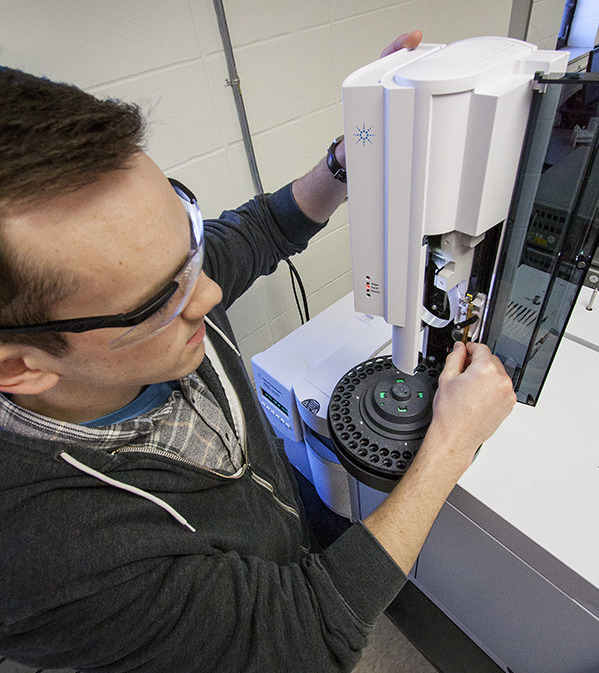 More than 50 percent of UW-La Crosse students have majors within the College of Science and Health. A planned reduction in the college’s supply and equipment budget — one strategy to deal with state budget cuts — will take hundreds of thousands of dollars out of labs that prepare students to work and do research in STEM fields.[/caption]
As Wisconsin legislators continue to meet and discuss a draft of the state budget, UW-La Crosse is holding budget meetings of its own. University leaders, faculty, staff and students are carefully evaluating how to handle a proposed, dramatic $7.6 million cut to the university’s budget while having the least impact on students’ academic experience.
The cuts are the result of a $300 million proposed state budget cut to the UW System in the 2015-17 biennial budget. That’s more than $15 million for UW-L over the next two years. This steep decline in state support brings UW-L back to state funding levels it received in 1998. It comes after 15 years of continued cuts to the university’s budget as state support for higher education has declined.
“The worst part of this cut is not the cut itself, but it’s the overall impact of bipartisan budget cutting to UW System over the last four budget cycles,” says Joe Heim, professor emeritus of political science and UW-L’s legislative liaison. “You cannot continue budget cuts of this magnitude over time without affecting quality.”
More than 50 percent of UW-La Crosse students have majors within the College of Science and Health. A planned reduction in the college’s supply and equipment budget — one strategy to deal with state budget cuts — will take hundreds of thousands of dollars out of labs that prepare students to work and do research in STEM fields.[/caption]
As Wisconsin legislators continue to meet and discuss a draft of the state budget, UW-La Crosse is holding budget meetings of its own. University leaders, faculty, staff and students are carefully evaluating how to handle a proposed, dramatic $7.6 million cut to the university’s budget while having the least impact on students’ academic experience.
The cuts are the result of a $300 million proposed state budget cut to the UW System in the 2015-17 biennial budget. That’s more than $15 million for UW-L over the next two years. This steep decline in state support brings UW-L back to state funding levels it received in 1998. It comes after 15 years of continued cuts to the university’s budget as state support for higher education has declined.
“The worst part of this cut is not the cut itself, but it’s the overall impact of bipartisan budget cutting to UW System over the last four budget cycles,” says Joe Heim, professor emeritus of political science and UW-L’s legislative liaison. “You cannot continue budget cuts of this magnitude over time without affecting quality.”
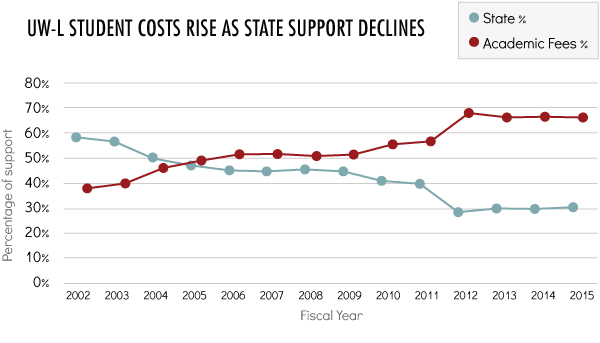 UW-La Crosse has so far cut 22 positions, mostly vacant, across the campus while planning to increase enrollment by 50 students in an attempt to deal with the cut. More position eliminations are involved in phase II of budget reductions and are still on the table.
During a university budget council meeting, UW-L Student Association President Kaylee Otterbacher asked if the university could cut any low enrollment courses. The response: UW-L has no low enrollment courses by UW System standards. Even currently “vacant” instructional positions on the list — that would appear to be possible for elimination — are not. They are being taught by temporary instructors to handle the strong demand until a replacement is found.
But the other solutions so far proposed to handle the multi-million dollar cut are also less than ideal. The university has strategized spreading the cut out across the university as much as possible so as to not cut any one area dramatically or deeply, explains UW-L Chancellor Joe Gow. “But that doesn’t minimize their negative impact,” he adds.
The vacant positions that have been eliminated so far provide services from financial aid and career services to advising and information technology. While these positions are not faculty, they still provide vital services to educate and guide students while on campus and into their future.
While increasing enrollment will bring in revenue and reduce the need to cut even more positions, it will have other ill effects such as a strain on faculty teaching loads, a decrease of student opportunities in larger classrooms, and a heavier burden on already overcrowded campus residence halls.
A seven percent reduction across the university in supply and expense budgets — although another strategy to minimize student impact — will affect students indirectly.
In the sciences, it will mean not replacing or repairing broken equipment as needed that helps students prepare for 21st century careers in STEM fields. In Murphy Library it will mean cancelling some of the databases, e-journals and other resources that student and classes across campus use in curriculum, instruction and research.
UW-La Crosse has so far cut 22 positions, mostly vacant, across the campus while planning to increase enrollment by 50 students in an attempt to deal with the cut. More position eliminations are involved in phase II of budget reductions and are still on the table.
During a university budget council meeting, UW-L Student Association President Kaylee Otterbacher asked if the university could cut any low enrollment courses. The response: UW-L has no low enrollment courses by UW System standards. Even currently “vacant” instructional positions on the list — that would appear to be possible for elimination — are not. They are being taught by temporary instructors to handle the strong demand until a replacement is found.
But the other solutions so far proposed to handle the multi-million dollar cut are also less than ideal. The university has strategized spreading the cut out across the university as much as possible so as to not cut any one area dramatically or deeply, explains UW-L Chancellor Joe Gow. “But that doesn’t minimize their negative impact,” he adds.
The vacant positions that have been eliminated so far provide services from financial aid and career services to advising and information technology. While these positions are not faculty, they still provide vital services to educate and guide students while on campus and into their future.
While increasing enrollment will bring in revenue and reduce the need to cut even more positions, it will have other ill effects such as a strain on faculty teaching loads, a decrease of student opportunities in larger classrooms, and a heavier burden on already overcrowded campus residence halls.
A seven percent reduction across the university in supply and expense budgets — although another strategy to minimize student impact — will affect students indirectly.
In the sciences, it will mean not replacing or repairing broken equipment as needed that helps students prepare for 21st century careers in STEM fields. In Murphy Library it will mean cancelling some of the databases, e-journals and other resources that student and classes across campus use in curriculum, instruction and research.
Enrollment growth by 50
[caption id="attachment_39981" align="alignleft" width="180"]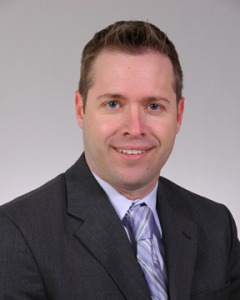 TJ Brooks, chair of UW-L's Economics Department[/caption]
The university aims to increase enrollment by an additional 50 students in fall 2015 to bring in additional revenue and lessen the weight of the cut.
TJ Brooks, chair of UW-L’s Economics Department, says the university would need almost three more full-time faculty to handle that many more students taking on a full-time credit load. Meanwhile, the university is looking for more positions to cut.
Insufficient faculty means students will have a harder time getting into the class they want, in some cases, classes they need to graduate, says Brooks. High demand classes like “Intro to Economics” will have to turn students away.
“Will we find a class for them in this situation? Most likely, yes. But will it be the class they wanted — maybe not,” says Brooks. “So, who suffers? The students.”
Inevitably the pressure will result in some faculty taking on more students. Couple that with additional responsibilities because of fewer student support services staff, and it means faculty will have less time to dedicate to each student. That could come in the form of fewer opportunities to do activities like in depth projects, presentations, or essays that demand more faculty grading and interaction, explains Brooks.
Although such moves may seem small and inconsequential at a glance, Brooks says they add up to an overall lower quality educational experience. An economist, Brooks describes the problem in terms of inflation.
“As anyone on a fixed income knows, while inflation may seem to slowly erode your purchasing power on a daily basis, one day you turn around you can only afford half as much as what you used to,” he says. “Moves like this slowly — or sometimes not so slowly — erode the quality of education we can offer.”
TJ Brooks, chair of UW-L's Economics Department[/caption]
The university aims to increase enrollment by an additional 50 students in fall 2015 to bring in additional revenue and lessen the weight of the cut.
TJ Brooks, chair of UW-L’s Economics Department, says the university would need almost three more full-time faculty to handle that many more students taking on a full-time credit load. Meanwhile, the university is looking for more positions to cut.
Insufficient faculty means students will have a harder time getting into the class they want, in some cases, classes they need to graduate, says Brooks. High demand classes like “Intro to Economics” will have to turn students away.
“Will we find a class for them in this situation? Most likely, yes. But will it be the class they wanted — maybe not,” says Brooks. “So, who suffers? The students.”
Inevitably the pressure will result in some faculty taking on more students. Couple that with additional responsibilities because of fewer student support services staff, and it means faculty will have less time to dedicate to each student. That could come in the form of fewer opportunities to do activities like in depth projects, presentations, or essays that demand more faculty grading and interaction, explains Brooks.
Although such moves may seem small and inconsequential at a glance, Brooks says they add up to an overall lower quality educational experience. An economist, Brooks describes the problem in terms of inflation.
“As anyone on a fixed income knows, while inflation may seem to slowly erode your purchasing power on a daily basis, one day you turn around you can only afford half as much as what you used to,” he says. “Moves like this slowly — or sometimes not so slowly — erode the quality of education we can offer.”
Into the residence halls
[caption id="attachment_39987" align="alignright" width="300"]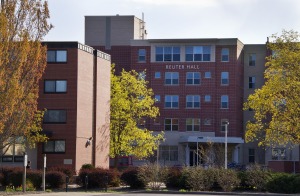 Increasing enrollment by 50 students to help deal with deep cuts to UW-L's budget will put a strain on already overcrowded residence halls.[/caption]
Classrooms aren’t the only area that will be challenged with higher numbers of students.
Residence life staff are figuring out how to accommodate an additional 50 incoming freshman this fall in already overcrowded residence halls. UW-L residence halls are designed to accommodate 3,200 students, yet this fall they will hold close to 3,600 students. This means thirty percent of students will be living in either double rooms that are rearranged to hold three people or study lounges that are converted to hold up to five students, says Nick Nicklaus, director of Residence Life.
Nicklaus adds that overcrowding doesn’t just impact the 400 “extra” students. It affects all of their roommates— about 1,200 total UW-L students — who are also living in rooms that were intended for fewer people.
Nicklaus says he doesn’t anticipate any relief coming soon as a proposal for a new residence hall on campus was recently denied by the State Building Commission for the 2015-17 capital budget. And the availability of off-campus housing is minimal, he adds.
While UW-L’s residence halls are still safe and meet all the necessary legal codes in this extended capacity, Nicklaus worries about students not getting enough privacy or study space. He anticipates overall wear and tear on the facilities from additional traffic will increase the urgency for repairs that have already been put off because of continuous budget cutbacks.
His management staff will continue to be asked to accommodate more students without additional support. Since 1997 the number of students who live in UW-L residence halls has increased by about 20 percent or 650 students. Yet the number of central office staff in residence life — who help build a community for all of these students — has never increased.
Nicklaus was hopeful he’d finally be able to hire two more assistant hall directors this spring, but a budget cut mean these residence life management positions are now off the table.
“When we increase the number of students living in halls, and then potentially have problems that arise with overcrowding, we are going to need more staff, so that’s a concern,” says Nicklaus.
Increasing enrollment by 50 students to help deal with deep cuts to UW-L's budget will put a strain on already overcrowded residence halls.[/caption]
Classrooms aren’t the only area that will be challenged with higher numbers of students.
Residence life staff are figuring out how to accommodate an additional 50 incoming freshman this fall in already overcrowded residence halls. UW-L residence halls are designed to accommodate 3,200 students, yet this fall they will hold close to 3,600 students. This means thirty percent of students will be living in either double rooms that are rearranged to hold three people or study lounges that are converted to hold up to five students, says Nick Nicklaus, director of Residence Life.
Nicklaus adds that overcrowding doesn’t just impact the 400 “extra” students. It affects all of their roommates— about 1,200 total UW-L students — who are also living in rooms that were intended for fewer people.
Nicklaus says he doesn’t anticipate any relief coming soon as a proposal for a new residence hall on campus was recently denied by the State Building Commission for the 2015-17 capital budget. And the availability of off-campus housing is minimal, he adds.
While UW-L’s residence halls are still safe and meet all the necessary legal codes in this extended capacity, Nicklaus worries about students not getting enough privacy or study space. He anticipates overall wear and tear on the facilities from additional traffic will increase the urgency for repairs that have already been put off because of continuous budget cutbacks.
His management staff will continue to be asked to accommodate more students without additional support. Since 1997 the number of students who live in UW-L residence halls has increased by about 20 percent or 650 students. Yet the number of central office staff in residence life — who help build a community for all of these students — has never increased.
Nicklaus was hopeful he’d finally be able to hire two more assistant hall directors this spring, but a budget cut mean these residence life management positions are now off the table.
“When we increase the number of students living in halls, and then potentially have problems that arise with overcrowding, we are going to need more staff, so that’s a concern,” says Nicklaus.
Cutting supply and expense
[caption id="attachment_39992" align="alignright" width="600"]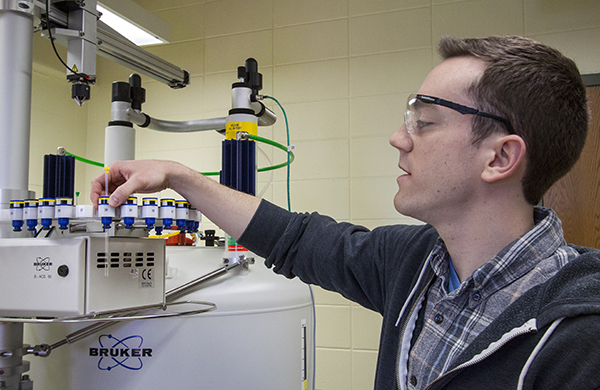 Repairs to this Nuclear Magnetic Resonance (NMR) Spectrometer cost about $30,000 last year. Funds for such repairs will be difficult or impossible to obtain in the future with budget cuts. The NMR, commonly found in private industry, gives students research and learning opportunities that prepare them for work in STEM fields. Here UW-L Senior Brian Peterson explains how he will be using the NMR in class to synthesize a molecule originally found in nature. The molecule was discovered last year, and was found to be toxic to cancer cells. “I’m thrilled about it,” says Peterson. “Having experience on this machine is huge, and without it I don’t think we’d be able to offer the same quality education we do at UW-L[/caption]
UW-L has another strategy to cut back while preserving teaching. Supply and expense budgets across campus will be cut by an average of seven percent. While seemingly a small percentage, those budgets are already taxed by inflation and years of previous budget cuts.
More than 50 percent of UW-L students are majors in the College of Science and Health. A seven percent across the board reduction to supply and equipment will take hundreds of thousands of dollars out of the college — and out of labs that prepare these students to work and do research in STEM fields, says Aaron Monte, professor and chair of Chemistry and Biochemistry.
Monte’s department alone has more than 20 different teaching and research laboratories that thousands of students use each week. Monte compares each lab to a home that frequently and unexpectedly needs updates and repairs. Instead of windows, roofing and refrigerator repairs, the labs need to repair and replace microscopes, spectrometers, balances, and other modern, high-tech equipment. This equipment helps prepare students for work in private businesses and research laboratories across the world.
UW-L Senior Brian Peterson points to several pieces of high-tech equipment he uses in the chemistry lab on a daily bases. One machine that allows him to analyze the product after a chemical reaction has broken twice in the last six months. Peterson says not repairing it would mean not getting experience using a common instrument he’ll find in graduate school next year and his future career working in industry.
“Getting that hands-on experience is instrumental for the shift into the work world,” says Peterson. “You can get 95 percent on all of your tests, but if you know how to use these instruments that’s what will really give you the leg up.”
Peterson is grateful the department has so far been able to come up with funds to make needed repairs to this and other machines. He has amassed more than 250 hours of chemistry lab time since he declared the chemistry major and knows that this was a big factor in his acceptance to graduate school at Cornell University next fall. Peterson would eventually like to work in private industry researching biodegradable plastics.
Since Monte started working at UW-L in 1995, his department has never had sufficient funds in its supply and equipment budget to cover needs. Yet costs of modern, scientific equipment have risen dramatically. Considering this funding area will now be cut back even more, Monte anticipates not being able to purchase and repair equipment in his labs as needed. Students will be less likely to get the hands-on lab experiences that employers value in the graduates they hire.
“UW-L is a flagship institution for training students in STEM fields,” says Monte. “To do a good job in these areas, we need levels of funding that enable us to provide a modern, 21st century experience.”
Repairs to this Nuclear Magnetic Resonance (NMR) Spectrometer cost about $30,000 last year. Funds for such repairs will be difficult or impossible to obtain in the future with budget cuts. The NMR, commonly found in private industry, gives students research and learning opportunities that prepare them for work in STEM fields. Here UW-L Senior Brian Peterson explains how he will be using the NMR in class to synthesize a molecule originally found in nature. The molecule was discovered last year, and was found to be toxic to cancer cells. “I’m thrilled about it,” says Peterson. “Having experience on this machine is huge, and without it I don’t think we’d be able to offer the same quality education we do at UW-L[/caption]
UW-L has another strategy to cut back while preserving teaching. Supply and expense budgets across campus will be cut by an average of seven percent. While seemingly a small percentage, those budgets are already taxed by inflation and years of previous budget cuts.
More than 50 percent of UW-L students are majors in the College of Science and Health. A seven percent across the board reduction to supply and equipment will take hundreds of thousands of dollars out of the college — and out of labs that prepare these students to work and do research in STEM fields, says Aaron Monte, professor and chair of Chemistry and Biochemistry.
Monte’s department alone has more than 20 different teaching and research laboratories that thousands of students use each week. Monte compares each lab to a home that frequently and unexpectedly needs updates and repairs. Instead of windows, roofing and refrigerator repairs, the labs need to repair and replace microscopes, spectrometers, balances, and other modern, high-tech equipment. This equipment helps prepare students for work in private businesses and research laboratories across the world.
UW-L Senior Brian Peterson points to several pieces of high-tech equipment he uses in the chemistry lab on a daily bases. One machine that allows him to analyze the product after a chemical reaction has broken twice in the last six months. Peterson says not repairing it would mean not getting experience using a common instrument he’ll find in graduate school next year and his future career working in industry.
“Getting that hands-on experience is instrumental for the shift into the work world,” says Peterson. “You can get 95 percent on all of your tests, but if you know how to use these instruments that’s what will really give you the leg up.”
Peterson is grateful the department has so far been able to come up with funds to make needed repairs to this and other machines. He has amassed more than 250 hours of chemistry lab time since he declared the chemistry major and knows that this was a big factor in his acceptance to graduate school at Cornell University next fall. Peterson would eventually like to work in private industry researching biodegradable plastics.
Since Monte started working at UW-L in 1995, his department has never had sufficient funds in its supply and equipment budget to cover needs. Yet costs of modern, scientific equipment have risen dramatically. Considering this funding area will now be cut back even more, Monte anticipates not being able to purchase and repair equipment in his labs as needed. Students will be less likely to get the hands-on lab experiences that employers value in the graduates they hire.
“UW-L is a flagship institution for training students in STEM fields,” says Monte. “To do a good job in these areas, we need levels of funding that enable us to provide a modern, 21st century experience.”
At the library
[caption id="attachment_39995" align="alignright" width="180"]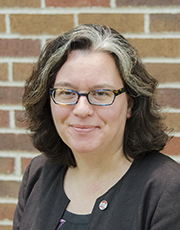 Catherine Lavallée-Welch[/caption]
After years of budget cuts, the library has made an extra effort every year to preserve its collections — such as databases and e-journals — that students, faculty and classes use as part of their curriculum, research and more. But this year the budget cut is too big and some of the collections will go, says Catherine Lavallée-Welch, director of Murphy Library.
“We are at a point where we are stretched very thin and it is going to be significant,” she says.
Cutting up to $78,000 from collections will mean cancelling subscriptions to e-journals, databases, newspapers, magazines, and/or reducing the number of videos or books purchased — either in circulation or in the reference collection. The library plans to gather feedback from faculty and students across campus and to prioritize saving collections that are necessary for departmental accreditation or cover a large part of curriculum.
“I understand that the state is in a difficult economic situation and cuts have to be made, but personally I think these cuts will be particularly difficult for the system and its libraries to absorb,” says Lavallée-Welch. “The libraries in the system collaborate and share many subscriptions to get better pricing. But the fact that we have to deal with 5-8 percent inflation in subscription costs every year and the lack of base funding increases since 1999 makes it difficult for us to do our job. That is, in part, making sure students and faculty have the resources they need for teaching, research and studies.”
The deadline to submit comments to the Joint Finance Committee is April 8. Find more state budget information on the UW-L Administration and Finance website.
Catherine Lavallée-Welch[/caption]
After years of budget cuts, the library has made an extra effort every year to preserve its collections — such as databases and e-journals — that students, faculty and classes use as part of their curriculum, research and more. But this year the budget cut is too big and some of the collections will go, says Catherine Lavallée-Welch, director of Murphy Library.
“We are at a point where we are stretched very thin and it is going to be significant,” she says.
Cutting up to $78,000 from collections will mean cancelling subscriptions to e-journals, databases, newspapers, magazines, and/or reducing the number of videos or books purchased — either in circulation or in the reference collection. The library plans to gather feedback from faculty and students across campus and to prioritize saving collections that are necessary for departmental accreditation or cover a large part of curriculum.
“I understand that the state is in a difficult economic situation and cuts have to be made, but personally I think these cuts will be particularly difficult for the system and its libraries to absorb,” says Lavallée-Welch. “The libraries in the system collaborate and share many subscriptions to get better pricing. But the fact that we have to deal with 5-8 percent inflation in subscription costs every year and the lack of base funding increases since 1999 makes it difficult for us to do our job. That is, in part, making sure students and faculty have the resources they need for teaching, research and studies.”
The deadline to submit comments to the Joint Finance Committee is April 8. Find more state budget information on the UW-L Administration and Finance website.